 Finally, I've reached the last two provinces of northeastern Luzon Island! Yes, we visited Cagayan and Isabela today. Just like the Ilocos trip in July last year, I joined the Arch 17 class of Prof. Jojo Mata for the semestral study tour organized by the UP College of Architecture HTC Lab.We left UP at 10 p.m yesterday and arrived in Cauayan, Isabela at 6 a.m. just in time for breakfast at the Jambalaya Grill. After a hearty breakfast, we went to the Magat Dam in Ramon. Although I was surprised to see a sign along the road a few meters from the dam that we were in Alfonso Lista, Ifugao.
Finally, I've reached the last two provinces of northeastern Luzon Island! Yes, we visited Cagayan and Isabela today. Just like the Ilocos trip in July last year, I joined the Arch 17 class of Prof. Jojo Mata for the semestral study tour organized by the UP College of Architecture HTC Lab.We left UP at 10 p.m yesterday and arrived in Cauayan, Isabela at 6 a.m. just in time for breakfast at the Jambalaya Grill. After a hearty breakfast, we went to the Magat Dam in Ramon. Although I was surprised to see a sign along the road a few meters from the dam that we were in Alfonso Lista, Ifugao.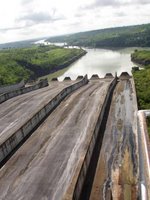 It was a massive structure which reminded me of the Marcosian-era of the Philippines, the last time when the Philippine government thought big. If there was one thing I would hand to Ferdinand Marcos and his wife Imelda, they left their legacies in architectural monuments such as the Cultural Center of the Philippines and massive infrastructure projects such as the Magat Dam. No other president after them left monumental legacies not including of course Ramos' white elephant known as Expo Filipino.From the Magat Dam, we went straight to our hotel in Tuguegarao City
It was a massive structure which reminded me of the Marcosian-era of the Philippines, the last time when the Philippine government thought big. If there was one thing I would hand to Ferdinand Marcos and his wife Imelda, they left their legacies in architectural monuments such as the Cultural Center of the Philippines and massive infrastructure projects such as the Magat Dam. No other president after them left monumental legacies not including of course Ramos' white elephant known as Expo Filipino.From the Magat Dam, we went straight to our hotel in Tuguegarao City in
Cagayan to freshen up, get some rest and have lunch. After lunch, we went to the Tuguegarao Cathedral, a heritage horror which Jojo calls a "good example of a bad example!" Imagine, they demolished the old brick convento right beside the church and replaced it with this horrible commercial structure and multi-purpose hall which is still under construction at this moment. Now you see why we can't entrust heritage decisions to some bishops because they themselves are at times the culprits.That also happened in Lingayen, Pangasinan just recently. Instead of demolishing these centuries-old conventos and replacing them with horrible new buildings, the bishops could have contacted the NCCA or a conservation architect to consult them on how to do adaptive reuse of the conventos, meaning tranforming the interior of the conventos in order for them to serve the purpose intended for new buildings. In that manner, heritage is preserved and the bishops get the income they want.
Imagine, they demolished the old brick convento right beside the church and replaced it with this horrible commercial structure and multi-purpose hall which is still under construction at this moment. Now you see why we can't entrust heritage decisions to some bishops because they themselves are at times the culprits.That also happened in Lingayen, Pangasinan just recently. Instead of demolishing these centuries-old conventos and replacing them with horrible new buildings, the bishops could have contacted the NCCA or a conservation architect to consult them on how to do adaptive reuse of the conventos, meaning tranforming the interior of the conventos in order for them to serve the purpose intended for new buildings. In that manner, heritage is preserved and the bishops get the income they want.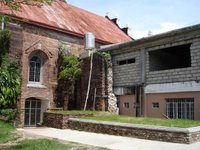 Yes, the bottomline was income for the bishops since commercial stalls replaced the old conventos when the said stalls could have been integrated properly with the old conventos had they consulted. Notice also the water tank on top of the demolished part of the convento. You can really see how some priests and bishops treat our national heritage.Tuguegarao is actually an urban planning disaster having transformed itself into another nondescript Philippine city without character. Not much of its heritage is left since Church and State seemed to have formed a perfect tandem in eradicating its rich past. Add to the fact that the roads are literally congested with tricycles. Yes people! After Cabanatuan, Tuguegarao follows with the most number of tricycle franchises issued. Driving in the city streets is a nightmare since the drivers treat the roads as if they were theirs.We then visited a horno, an oven for baking bricks, in some forgotten corner of the city. I guess the city government has no plans of caring for the site since it's already hidden in a rundown residential area right beside a basketball court which is obviously more important to the people than this relic of the past.
Yes, the bottomline was income for the bishops since commercial stalls replaced the old conventos when the said stalls could have been integrated properly with the old conventos had they consulted. Notice also the water tank on top of the demolished part of the convento. You can really see how some priests and bishops treat our national heritage.Tuguegarao is actually an urban planning disaster having transformed itself into another nondescript Philippine city without character. Not much of its heritage is left since Church and State seemed to have formed a perfect tandem in eradicating its rich past. Add to the fact that the roads are literally congested with tricycles. Yes people! After Cabanatuan, Tuguegarao follows with the most number of tricycle franchises issued. Driving in the city streets is a nightmare since the drivers treat the roads as if they were theirs.We then visited a horno, an oven for baking bricks, in some forgotten corner of the city. I guess the city government has no plans of caring for the site since it's already hidden in a rundown residential area right beside a basketball court which is obviously more important to the people than this relic of the past. But these depressing episodes would soon be forgotten as we crossed into the next town Peñablanca to visit the Peñablanca Protected Landscapes and Seascapes, in particular, the famous Callao Caves. The image of the caves is so popular owing to the little chapel inside a large cavern which receives sunlight from a natural opening above. Finally, I get to visit the famous caves. But the signature ray of sunlight wasn't there since it enters the cave only at a particular time of the day.Getting up to the caves can be exhausting thanks to the 183 steps you have to climb to get to the top! But you will be rewarded with surreal rock formations that are very easy to explore.
But these depressing episodes would soon be forgotten as we crossed into the next town Peñablanca to visit the Peñablanca Protected Landscapes and Seascapes, in particular, the famous Callao Caves. The image of the caves is so popular owing to the little chapel inside a large cavern which receives sunlight from a natural opening above. Finally, I get to visit the famous caves. But the signature ray of sunlight wasn't there since it enters the cave only at a particular time of the day.Getting up to the caves can be exhausting thanks to the 183 steps you have to climb to get to the top! But you will be rewarded with surreal rock formations that are very easy to explore.
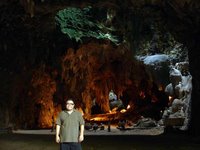 After the caves, we went down to the banks of the Pinacanauan River for a boat trip that offered us spectacular views of limestone cliffs covered with lush forests. Indeed, this was a reminder that the Philippines had a lot to offer and if we let all of this go by neglecting our natural heritage, it's the next generation of Filipinos that would suffer.I really hope illegal logging in this part of the country, particularly Cagayan and Isabela, is stopped. But we all know why it still goes on. If politicians in the area can't curb illegal logging, it's either they are weak and don't have the political will, or more plausible is that they are earning from it as well!
After the caves, we went down to the banks of the Pinacanauan River for a boat trip that offered us spectacular views of limestone cliffs covered with lush forests. Indeed, this was a reminder that the Philippines had a lot to offer and if we let all of this go by neglecting our natural heritage, it's the next generation of Filipinos that would suffer.I really hope illegal logging in this part of the country, particularly Cagayan and Isabela, is stopped. But we all know why it still goes on. If politicians in the area can't curb illegal logging, it's either they are weak and don't have the political will, or more plausible is that they are earning from it as well! We went back to Tuguegarao to get our long-needed rest and for dinner of course. The next day's itinerary was mostly church heritage. I'm quite excited since I rarely visit the Cagayan Valley owing to its distance from Manila. Last time I visited was in 2002 during a conference in Bayombong, Nueva Vizcaya. As part of the conference we visited the church in Dupax del Sur which is a national cultural treasure.It looks like I'm close to completing the provinces of Luzon Island soon. With my visits to Isabela and Cagayan today, that leaves seven namely Quirino, Kalinga, Apayao, Abra, Aurora, Camarines Norte, and Sorsogon; plus of course six island provinces of Luzon which are Batanes, Occidental Mindoro, Romblon, Marinduque, Masbate and Catanduanes which I hope to visit in the near future. Hehe!
We went back to Tuguegarao to get our long-needed rest and for dinner of course. The next day's itinerary was mostly church heritage. I'm quite excited since I rarely visit the Cagayan Valley owing to its distance from Manila. Last time I visited was in 2002 during a conference in Bayombong, Nueva Vizcaya. As part of the conference we visited the church in Dupax del Sur which is a national cultural treasure.It looks like I'm close to completing the provinces of Luzon Island soon. With my visits to Isabela and Cagayan today, that leaves seven namely Quirino, Kalinga, Apayao, Abra, Aurora, Camarines Norte, and Sorsogon; plus of course six island provinces of Luzon which are Batanes, Occidental Mindoro, Romblon, Marinduque, Masbate and Catanduanes which I hope to visit in the near future. Hehe!
 They call it a piece of Hawaii in the Philippines. But indeed, the Mount Malarayat Golf and Country Club in Lipa, Batangas offers some of the best views of Philippine landscape architecture at its finest. I was lucky to spend a relaxing day enjoying the serene views of a well-landscaped golf course amidst the backdrop of Mount Malarayat. Such a conducive place for a meeting that would otherwise have been quite exhausting if not for the great view from the function room.It turns out, the landscape architects were led by none other than National Artist for Architecture, Ildefonso P. Santos and Associates as well as Pesons, Dimanlig, Aleta, Alcazaren (PDAA) Partners whom I believe are professors of landscape architecture at the University of the Philippines.I hope we get more of the Philippines landscaped by professionals!
They call it a piece of Hawaii in the Philippines. But indeed, the Mount Malarayat Golf and Country Club in Lipa, Batangas offers some of the best views of Philippine landscape architecture at its finest. I was lucky to spend a relaxing day enjoying the serene views of a well-landscaped golf course amidst the backdrop of Mount Malarayat. Such a conducive place for a meeting that would otherwise have been quite exhausting if not for the great view from the function room.It turns out, the landscape architects were led by none other than National Artist for Architecture, Ildefonso P. Santos and Associates as well as Pesons, Dimanlig, Aleta, Alcazaren (PDAA) Partners whom I believe are professors of landscape architecture at the University of the Philippines.I hope we get more of the Philippines landscaped by professionals!
I really wonder how long it will take the board of the National Historical Institute to declare more heritage towns. At the moment, only five are in the NHI list namely Silay in Negros Occidental, Taal in Batangas, Pila in Laguna, Dapitan in Zamboanga del Norte and Malolos in Bulacan. Vigan of course is already a UNESCO World Heritage Site. But many candidates have been screaming for declarations such as San Miguel de Mayumu in Bulacan, Sariaya in Quezon Province, San Juan in Batangas and Carcar in Cebu Province. As I promised last March, I would talk more about the heritage town of Carcar. I was looking through some old articles on Carcar and it turns out, there was already a bill proposed in Congress. I wonder why it had to be done when it needed a simple board resolution from the NHI. Anyway, the article from the Manila Bulletin dated May 1, 2005 states, "Cebu Rep. Eduardo Gullas has filed a bill seeking to declare the municipality of Carcar, home to numerous historical structures and artifacts, a national cultural heritage zone.
As I promised last March, I would talk more about the heritage town of Carcar. I was looking through some old articles on Carcar and it turns out, there was already a bill proposed in Congress. I wonder why it had to be done when it needed a simple board resolution from the NHI. Anyway, the article from the Manila Bulletin dated May 1, 2005 states, "Cebu Rep. Eduardo Gullas has filed a bill seeking to declare the municipality of Carcar, home to numerous historical structures and artifacts, a national cultural heritage zone.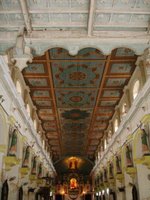 "Located about 40 kilometers southwest of Cebu City, Carcar is just like Vigan City in Ilocos Sur, boasting of various architecturally significant vintage houses built during the Spanish era and a classical church, Gullas said."A cultural heritage zone refers to historical, anthropological, archaeological and artistic geographical areas and settings that are actually culturally important to the country."It has become absolutely necessary for us to preserve and protect Carcar's historical structures in the interest of enriching the national patrimony," Gullas said.
"Located about 40 kilometers southwest of Cebu City, Carcar is just like Vigan City in Ilocos Sur, boasting of various architecturally significant vintage houses built during the Spanish era and a classical church, Gullas said."A cultural heritage zone refers to historical, anthropological, archaeological and artistic geographical areas and settings that are actually culturally important to the country."It has become absolutely necessary for us to preserve and protect Carcar's historical structures in the interest of enriching the national patrimony," Gullas said. "Century-old buildings that still stand up to now remind the youth of the grandeur and aesthetic splendor of the architectural design of the past," Gullas added.The article adds, "Under House Bill 3762, Carcar, once declared a cultural heritage zone, shall be subject to the rules and regulations governing the preservation of such sites."I salute Congressman Gullas for this effort. Maybe the congressmen of the other towns I've mentioned should file similar bills since it seems it will take the NHI forever to make the badly-needed declarations.
"Century-old buildings that still stand up to now remind the youth of the grandeur and aesthetic splendor of the architectural design of the past," Gullas added.The article adds, "Under House Bill 3762, Carcar, once declared a cultural heritage zone, shall be subject to the rules and regulations governing the preservation of such sites."I salute Congressman Gullas for this effort. Maybe the congressmen of the other towns I've mentioned should file similar bills since it seems it will take the NHI forever to make the badly-needed declarations. As Architect Toti Villalon stated in his column last December 2005, "A model for public-private cooperation is now in place with the recent provincial declaration of Carcar as a Heritage Town and the passing of the Carcar heritage bill which designates heritage zones, levels of protection for heritage structures, and, most importantly, enlists the participation of the Carcar Heritage Conservation Society to provide technical expertise in the task of preserving their historic town."
As Architect Toti Villalon stated in his column last December 2005, "A model for public-private cooperation is now in place with the recent provincial declaration of Carcar as a Heritage Town and the passing of the Carcar heritage bill which designates heritage zones, levels of protection for heritage structures, and, most importantly, enlists the participation of the Carcar Heritage Conservation Society to provide technical expertise in the task of preserving their historic town."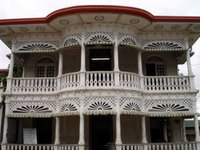 In an earlier column, Toti describes the town, "Carcar's treasures go beyond the town's colonial homes, church and convento."Its calado architecture from the 1920s is unsurpassed in the country. The wooden faćades of the Carcar Dispensary and Saint Catherine's Academy have carved fretwork so delicate it seems like they could flutter with the breeze like fragile heirloom lace."Wooden houses from the unappreciated post-war era still stand in Carcar streets, a type of architecture so descriptive of life during that forgotten period of our national history which is sadly dismissed by many as not of heritage quality.
In an earlier column, Toti describes the town, "Carcar's treasures go beyond the town's colonial homes, church and convento."Its calado architecture from the 1920s is unsurpassed in the country. The wooden faćades of the Carcar Dispensary and Saint Catherine's Academy have carved fretwork so delicate it seems like they could flutter with the breeze like fragile heirloom lace."Wooden houses from the unappreciated post-war era still stand in Carcar streets, a type of architecture so descriptive of life during that forgotten period of our national history which is sadly dismissed by many as not of heritage quality.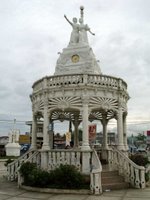 "A wonderful round kiosk from the American period, one of the best surviving examples of its genre in the country, valiantly stands at the center of the Carcar Rotunda, whose pride of place is now totally stolen by offending super large-scale billboards."Indeed, that kiosk is one of a kind. I remember it was at the heart of a controversy between the townsfolk and the DPWH who proposed that it be demolished to giveway to some road widening. Yikes! There go our government engineers again who churn up the ugliest infrastructure in the world! Good thing the opposition to the DPWH plan was loud and clear.Carcar is now protected not just by a provincial resolution but by a national law. But the question still is, didn't that need only a simple board resolution from the NHI?
"A wonderful round kiosk from the American period, one of the best surviving examples of its genre in the country, valiantly stands at the center of the Carcar Rotunda, whose pride of place is now totally stolen by offending super large-scale billboards."Indeed, that kiosk is one of a kind. I remember it was at the heart of a controversy between the townsfolk and the DPWH who proposed that it be demolished to giveway to some road widening. Yikes! There go our government engineers again who churn up the ugliest infrastructure in the world! Good thing the opposition to the DPWH plan was loud and clear.Carcar is now protected not just by a provincial resolution but by a national law. But the question still is, didn't that need only a simple board resolution from the NHI?
Related article
On another note, check out the article Church heritage and the Pardo controversy in the Cebu Daily News which is related to our petition to the CBCP. It shows you how many of our priests think. What's sick about the Pardo issue is the fact that Cardinal Vidal already came out with an order for all priests to seek approval of Cebu's Archdiocesan Commission for the Cultural Heritage of the Church for any church renovation but priests still disregard it.
 The past three days have been dedicated to meetings and surveying of the heritage sites of San Fernando. We are one in a rare breed of cities in the country which are agressively pursuing heritage conservation. On Wednesday, we met with representatives of the San Fernando, Pampanga Heritage Foundation, Filipino-American Memorial Endowment, American Chamber of Commerce, Battling Bastards of Bataan and the Defenders of Bataan and Corregidor regarding the plans of the city to restore the San Fernando Train Station and to open a Death March memorial and museum in the site.
The past three days have been dedicated to meetings and surveying of the heritage sites of San Fernando. We are one in a rare breed of cities in the country which are agressively pursuing heritage conservation. On Wednesday, we met with representatives of the San Fernando, Pampanga Heritage Foundation, Filipino-American Memorial Endowment, American Chamber of Commerce, Battling Bastards of Bataan and the Defenders of Bataan and Corregidor regarding the plans of the city to restore the San Fernando Train Station and to open a Death March memorial and museum in the site.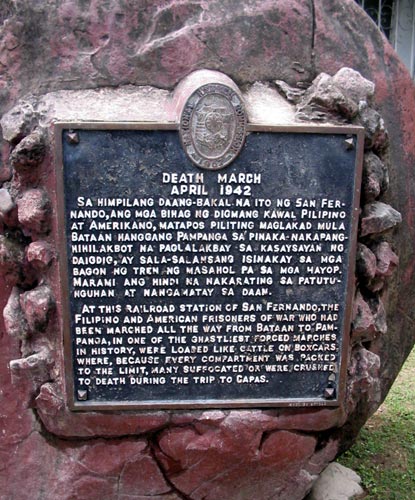 For those who are not yet aware of the significance of the said train station, it was the ending point of the long 102-kilometer walk from Mariveles, Bataan in April 1942. At the station, thousands of Filipino and American POWs were stuffed like sardines into box carts and transported to Capas, Tarlac. Anyway, expect more updates but the biggest hurdle is the slow response of the Philippine National Railways Corporation which is the owner of the said property.Yesterday was my rest day. I spent my 27th at home sleeping. Hehe! I decided that the best way for me to celebrate was to give myself the rest I badly needed.
For those who are not yet aware of the significance of the said train station, it was the ending point of the long 102-kilometer walk from Mariveles, Bataan in April 1942. At the station, thousands of Filipino and American POWs were stuffed like sardines into box carts and transported to Capas, Tarlac. Anyway, expect more updates but the biggest hurdle is the slow response of the Philippine National Railways Corporation which is the owner of the said property.Yesterday was my rest day. I spent my 27th at home sleeping. Hehe! I decided that the best way for me to celebrate was to give myself the rest I badly needed.  Today, a survey team of the National Historical Institute arrived to inspect more houses for possible declaration. San Fernando is trying to increase its number of declared structures and glad to say, all the other house owners have already given their consent and are excited about the possible declaration. For one, the city will soon be granting real estate tax exemptions to all heritage house owners to encourage them to preserve their homes.
Today, a survey team of the National Historical Institute arrived to inspect more houses for possible declaration. San Fernando is trying to increase its number of declared structures and glad to say, all the other house owners have already given their consent and are excited about the possible declaration. For one, the city will soon be granting real estate tax exemptions to all heritage house owners to encourage them to preserve their homes. Among the strongest contenders is the Singian House which was built in the mid-19th century. It could in fact be the oldest surviving house in San Fernando. The house is very well-maintained by its current owners. If it was indeed built in the 1850s, I suspect its original owner was Don Bernardino Singian de Miranda, a former gobernadorcillo of San Fernando from whom many of San Fernando's prominent families trace their roots. Don Bernardino is the grandfather of eminent pre-war surgeon Dr. Gregorio Singian.Beside the house is a really large camalig which is very well-preserved also. Structures like these form part of the industrial heritage of the city and are a rarity nowadays.
Among the strongest contenders is the Singian House which was built in the mid-19th century. It could in fact be the oldest surviving house in San Fernando. The house is very well-maintained by its current owners. If it was indeed built in the 1850s, I suspect its original owner was Don Bernardino Singian de Miranda, a former gobernadorcillo of San Fernando from whom many of San Fernando's prominent families trace their roots. Don Bernardino is the grandfather of eminent pre-war surgeon Dr. Gregorio Singian.Beside the house is a really large camalig which is very well-preserved also. Structures like these form part of the industrial heritage of the city and are a rarity nowadays. Another strong contender is the charming Victorian-inspired Hizon House along Consunji Street. It was built by Don Teodoro Santos, Jr. and Dona Africa Ventura and later purchased by Maria Hizon who served as a nurse in the Philippine Revolutionary Army. It is currently owned by the heirs of her nephew, Don Augusto Hizon.There are more candidates in the list. But it's all up to the NHI Board which has the final say. This however may take longer than it used to since I heard the board rarely convenes for meetings. Sigh!I guess that's it for now. To learn more about the heritage sites in San Fernando, click here.
Another strong contender is the charming Victorian-inspired Hizon House along Consunji Street. It was built by Don Teodoro Santos, Jr. and Dona Africa Ventura and later purchased by Maria Hizon who served as a nurse in the Philippine Revolutionary Army. It is currently owned by the heirs of her nephew, Don Augusto Hizon.There are more candidates in the list. But it's all up to the NHI Board which has the final say. This however may take longer than it used to since I heard the board rarely convenes for meetings. Sigh!I guess that's it for now. To learn more about the heritage sites in San Fernando, click here.
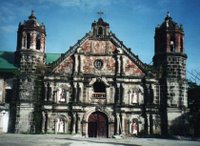 In the Kapampangan language, churches are called pisamban. One of the very first websites I made way back in college was on the churches of Pampanga. I remember that I spent two weeks traveling around the province of Pampanga searching for its heritage sites. At that time, there was no inventory of heritage sites. And the information and photos I collected eventually became the jump off point for the heritage conservation campaign in Pampanga.This I made available on the net through the website Pisamban: Churches of Pampanga (as of October 2009, Geocities is no longer online) among others. I was no longer able to update it since the files were lost when my computer crashed several years back. Above is a photo of the Minalin Church while the one below can be found in San Luis. Anyway, there are more photos of Pampanga and San Fernando heritage churches and other structures in my Yahoo! Photos.
In the Kapampangan language, churches are called pisamban. One of the very first websites I made way back in college was on the churches of Pampanga. I remember that I spent two weeks traveling around the province of Pampanga searching for its heritage sites. At that time, there was no inventory of heritage sites. And the information and photos I collected eventually became the jump off point for the heritage conservation campaign in Pampanga.This I made available on the net through the website Pisamban: Churches of Pampanga (as of October 2009, Geocities is no longer online) among others. I was no longer able to update it since the files were lost when my computer crashed several years back. Above is a photo of the Minalin Church while the one below can be found in San Luis. Anyway, there are more photos of Pampanga and San Fernando heritage churches and other structures in my Yahoo! Photos. Just to update everyone regarding our petition to the CBCP, we've collected more than 500 signatures to date and more are still coming in. It has been gaining so much momentum, international attention and support is pouring in as well. We have received letters of support from international conservation agencies such as the World Monuments Fund, the International Council on Monuments and Sites (ICOMOS) and its various national committees worldwide, and the Partners for Sacred Places among many others. If you haven't signed yet, please do at http://www.petitiononline.com/cbcp.
Just to update everyone regarding our petition to the CBCP, we've collected more than 500 signatures to date and more are still coming in. It has been gaining so much momentum, international attention and support is pouring in as well. We have received letters of support from international conservation agencies such as the World Monuments Fund, the International Council on Monuments and Sites (ICOMOS) and its various national committees worldwide, and the Partners for Sacred Places among many others. If you haven't signed yet, please do at http://www.petitiononline.com/cbcp.
The Vatican actually has a Pontifical Commission for the Cultural Heritage of the Church. In a 2001 circular letter, its president His Eminence Francesco Cardinal Marchisano says, "The cultural treasures of the Church make up the specific patrimony of the Christian community. At the same time, as a result of the universal dimension of the Christian message, they belong to the whole of humanity. Their end is the same as the Church's mission in its twofold work of Christian evangelization and promoting the human being. Their value lies in highlighting the activity of inculturating the faith. (emphasis mine)"
He adds, “The value that the Church places on her cultural goods explains ‘the will on the part of the community of faithful, and in particular ecclesiastical institutions, to gather since the apostolic period the testimonies of faith and nourish their memory, express the uniqueness and continuity of the Church that lives out these last periods of history’ (Pontifical Commission for the Cultural Heritage of the Church, Circular Letter The Pastoral Function of Church Archives, see n. 1.1.). Thus, the Church considers as crucial the handing down of her own patrimony of cultural goods. They represent, in fact, an essential link in the chain of Tradition; they are the visible memory of evangelization; they become a pastoral instrument. It follows therefore the effort ‘to restore, preserve, catalogue, and protect’ them (John Paul II, Address of October 12, 1995, see n. 4) in order to assure that they are treasured, ‘thus promoting a greater knowledge and suitable use in catechesis and in the liturgy’ (ibid.). (emphasis mine again)”
 Finally, I've reached the last two provinces of northeastern Luzon Island! Yes, we visited Cagayan and Isabela today. Just like the Ilocos trip in July last year, I joined the Arch 17 class of Prof. Jojo Mata for the semestral study tour organized by the UP College of Architecture HTC Lab.
Finally, I've reached the last two provinces of northeastern Luzon Island! Yes, we visited Cagayan and Isabela today. Just like the Ilocos trip in July last year, I joined the Arch 17 class of Prof. Jojo Mata for the semestral study tour organized by the UP College of Architecture HTC Lab. It was a massive structure which reminded me of the Marcosian-era of the Philippines, the last time when the Philippine government thought big. If there was one thing I would hand to Ferdinand Marcos and his wife Imelda, they left their legacies in architectural monuments such as the Cultural Center of the Philippines and massive infrastructure projects such as the Magat Dam. No other president after them left monumental legacies not including of course Ramos' white elephant known as Expo Filipino.
It was a massive structure which reminded me of the Marcosian-era of the Philippines, the last time when the Philippine government thought big. If there was one thing I would hand to Ferdinand Marcos and his wife Imelda, they left their legacies in architectural monuments such as the Cultural Center of the Philippines and massive infrastructure projects such as the Magat Dam. No other president after them left monumental legacies not including of course Ramos' white elephant known as Expo Filipino. Imagine, they demolished the old brick convento right beside the church and replaced it with this horrible commercial structure and multi-purpose hall which is still under construction at this moment. Now you see why we can't entrust heritage decisions to some bishops because they themselves are at times the culprits.
Imagine, they demolished the old brick convento right beside the church and replaced it with this horrible commercial structure and multi-purpose hall which is still under construction at this moment. Now you see why we can't entrust heritage decisions to some bishops because they themselves are at times the culprits. Yes, the bottomline was income for the bishops since commercial stalls replaced the old conventos when the said stalls could have been integrated properly with the old conventos had they consulted. Notice also the water tank on top of the demolished part of the convento. You can really see how some priests and bishops treat our national heritage.
Yes, the bottomline was income for the bishops since commercial stalls replaced the old conventos when the said stalls could have been integrated properly with the old conventos had they consulted. Notice also the water tank on top of the demolished part of the convento. You can really see how some priests and bishops treat our national heritage. But these depressing episodes would soon be forgotten as we crossed into the next town Peñablanca to visit the Peñablanca Protected Landscapes and Seascapes, in particular, the famous Callao Caves. The image of the caves is so popular owing to the little chapel inside a large cavern which receives sunlight from a natural opening above. Finally, I get to visit the famous caves. But the signature ray of sunlight wasn't there since it enters the cave only at a particular time of the day.
But these depressing episodes would soon be forgotten as we crossed into the next town Peñablanca to visit the Peñablanca Protected Landscapes and Seascapes, in particular, the famous Callao Caves. The image of the caves is so popular owing to the little chapel inside a large cavern which receives sunlight from a natural opening above. Finally, I get to visit the famous caves. But the signature ray of sunlight wasn't there since it enters the cave only at a particular time of the day. After the caves, we went down to the banks of the Pinacanauan River for a boat trip that offered us spectacular views of limestone cliffs covered with lush forests. Indeed, this was a reminder that the Philippines had a lot to offer and if we let all of this go by neglecting our natural heritage, it's the next generation of Filipinos that would suffer.
After the caves, we went down to the banks of the Pinacanauan River for a boat trip that offered us spectacular views of limestone cliffs covered with lush forests. Indeed, this was a reminder that the Philippines had a lot to offer and if we let all of this go by neglecting our natural heritage, it's the next generation of Filipinos that would suffer. We went back to Tuguegarao to get our long-needed rest and for dinner of course. The next day's itinerary was mostly church heritage. I'm quite excited since I rarely visit the Cagayan Valley owing to its distance from Manila. Last time I visited was in 2002 during a conference in Bayombong, Nueva Vizcaya. As part of the conference we visited the church in Dupax del Sur which is a national cultural treasure.
We went back to Tuguegarao to get our long-needed rest and for dinner of course. The next day's itinerary was mostly church heritage. I'm quite excited since I rarely visit the Cagayan Valley owing to its distance from Manila. Last time I visited was in 2002 during a conference in Bayombong, Nueva Vizcaya. As part of the conference we visited the church in Dupax del Sur which is a national cultural treasure.













